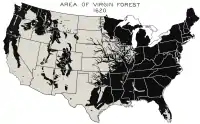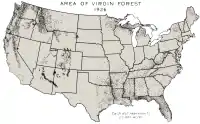Deforestation in the United States
Deforestation in the United States was an ongoing process until recently. Between 2010 and 2020, the US forests increased 0.03% annually, according to FAO (Food and Agriculture Organization of the United Nations).[lower-alpha 1]



Prior to the arrival of European-Americans, about one half of the United States land area was forest, about 1,023,000,000 acres (4,140,000 km2) estimated in 1630. Forest cover in the Eastern United States reached its lowest point in roughly 1872 with about 48 percent compared to the amount of forest cover in 1620. The majority of deforestation took place prior to 1910 with the Forest Service reporting the minimum forestation as 721,000,000 acres (2,920,000 km2) around 1920.[1] The forest resources of the United States have remained relatively constant through the 20th century.[2] The Forest Service reported total forestation as 766,000,000 acres (3,100,000 km2) in 2012.[3][4][2] A 2017 study estimated 3 percent loss of forest between 1992-2001.[5]
The 2005 (FAO) Global Forest Resources Assessment ranked the United States as seventh highest country losing its old growth forests, a vast majority of which were removed prior to the 20th century.[2]
After European colonization
For the 300 years following the arrival of Europeans, land was cleared, mostly for agriculture, at a rate that matched that of population growth.[6] For every person added to the population, one to two hectares of land was cultivated.[7] This trend continued until the 1920s when the amount of crop land stabilized in spite of continued population growth. As abandoned farm land reverted to forest the amount of forest land increased reaching a peak in 1963 of 753,000,000 acres (3,050,000 km2).[3]
After 1963 there was a gradual decrease through the next few decades which has been reversed with recovery and slight gains in the early 21st century. Gains in forest land have resulted from conversions from crop land and pastures at a higher rate than loss of forest to development. However issues have been identified such as the continued loss of old-growth forest,[8] the increased fragmentation of forest lands, and the increased urbanization of forest land.[9]
Previous issues

Deforestation in the United States was affected by many factors. One such factor was the effect, whether positive or negative, that the logging industry has on forests in the country. Logging in the United States is a hotly debated topic as groups who either support or oppose logging argue over its benefits and negative effects.
The biggest issue thought to be facing deforestation in the United States was illegal logging. The Forest Service and EPA work together to make sure that the permits for logging companies in the United States are granted in such a way that the forests are kept healthy and sustainable, and illegal logging reduces the chances that forests will be kept this way.
It has also been argued that trees can lower temperatures by around 10 degree Fahrenheit and their removal can lead to warmer temperatures.[10]
Species extinctions in the Eastern forests
Of the 28 forest bird species with habitat exclusively in that forest, Pimm claims four become extinct either wholly or mostly because of habitat loss, the passenger pigeon, Carolina parakeet, ivory-billed woodpecker, and Bachman's warbler.[11]
See also
Notes
- See FAO 2020, p. 18, table 8.
References
- "Major Trends, Forest Inventory & Analysis, 2002" (PDF). United States Forest Service. Retrieved 2016-09-24.
- Forest Resources of the United States Archived May 7, 2009, at the Wayback Machine
- "Forest Facts, 2012" (PDF). United States Forest Service. 2014-08-31. Retrieved 2016-09-30.
- "National Report on Sustainable Forests — 2010". United States Forest Service. 2014-04-29. Retrieved 2016-09-24.
- Yin, Steph (2017-02-23). "How Far to the Next Forest? A New Way to Measure Deforestation". The New York Times. ISSN 0362-4331. Retrieved 2020-05-06.
- 'Collapse': How Societies choose to Fail or Succeed, The New York Times
- American Forest A History of Resiliency and Recovery United States Forest Service
- United Nations (2005) "Global Forest Resources Assessment"
- U.S. Department of Agriculture "Forests on the Edge - Housing Development on America's Private Forests" (2005) http://www.fs.fed.us/projects/fote/reports/fote-6-9-05.pdf Retrieved November 19, 2006
- Amy Chillag. "US cities are losing 36 million trees a year. Here's why it matters and how you can stop it". CNN. Retrieved 2020-11-22.
- Pimm, Stuart (2002). "The Dodo became extinct (and other ecological myths)" (PDF). Annals of the Missouri Botanical Garden. Missouri Botanical Garden Press. 89 (2): 190–198. doi:10.2307/3298563. JSTOR 3298563. Archived from the original (PDF) on 2009-03-27.
Sources
- FAO (2020). "Global Forest Resources Assessment" (PDF).CS1 maint: ref=harv (link)
External links
| Wikimedia Commons has media related to Deforestation in the United States. |
- United States Forest Service
- Save America's Forests - environmental lobby group

.svg.png.webp)